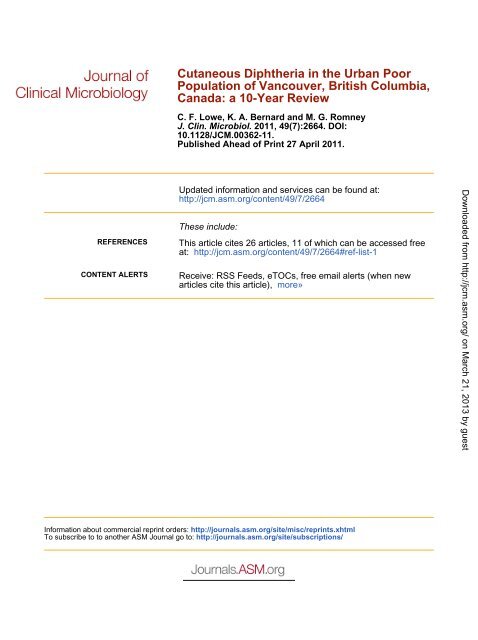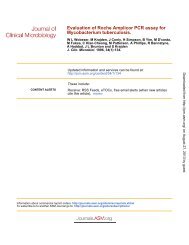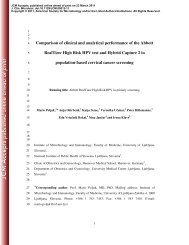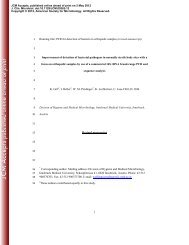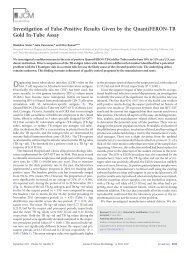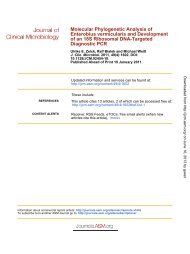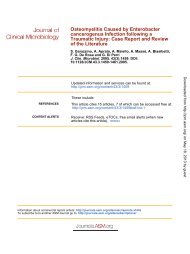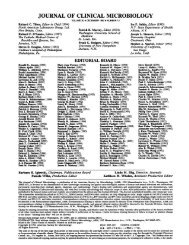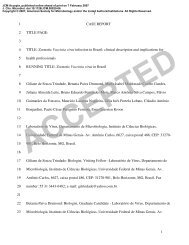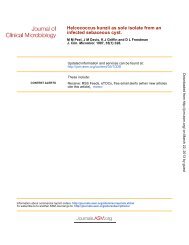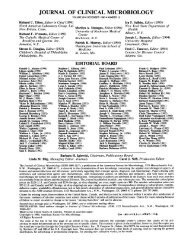Cutaneous Diphtheria in the Urban Poor Population of Vancouver ...
Cutaneous Diphtheria in the Urban Poor Population of Vancouver ...
Cutaneous Diphtheria in the Urban Poor Population of Vancouver ...
You also want an ePaper? Increase the reach of your titles
YUMPU automatically turns print PDFs into web optimized ePapers that Google loves.
REFERENCES<br />
CONTENT ALERTS<br />
<strong>Cutaneous</strong> <strong>Diph<strong>the</strong>ria</strong> <strong>in</strong> <strong>the</strong> <strong>Urban</strong> <strong>Poor</strong><br />
<strong>Population</strong> <strong>of</strong> <strong>Vancouver</strong>, British Columbia,<br />
Canada: a 10-Year Review<br />
C. F. Lowe, K. A. Bernard and M. G. Romney<br />
J. Cl<strong>in</strong>. Microbiol. 2011, 49(7):2664. DOI:<br />
10.1128/JCM.00362-11.<br />
Published Ahead <strong>of</strong> Pr<strong>in</strong>t 27 April 2011.<br />
Updated <strong>in</strong>formation and services can be found at:<br />
http://jcm.asm.org/content/49/7/2664<br />
These <strong>in</strong>clude:<br />
This article cites 26 articles, 11 <strong>of</strong> which can be accessed free<br />
at: http://jcm.asm.org/content/49/7/2664#ref-list-1<br />
Receive: RSS Feeds, eTOCs, free email alerts (when new<br />
articles cite this article), more»<br />
Information about commercial repr<strong>in</strong>t orders: http://journals.asm.org/site/misc/repr<strong>in</strong>ts.xhtml<br />
To subscribe to to ano<strong>the</strong>r ASM Journal go to: http://journals.asm.org/site/subscriptions/<br />
Downloaded from<br />
http://jcm.asm.org/<br />
on March 21, 2013 by guest
JOURNAL OF CLINICAL MICROBIOLOGY, July 2011, p. 2664–2666 Vol. 49, No. 7<br />
0095-1137/11/$12.00 doi:10.1128/JCM.00362-11<br />
Copyright © 2011, American Society for Microbiology. All Rights Reserved.<br />
NOTES<br />
<strong>Cutaneous</strong> <strong>Diph<strong>the</strong>ria</strong> <strong>in</strong> <strong>the</strong> <strong>Urban</strong> <strong>Poor</strong> <strong>Population</strong> <strong>of</strong> <strong>Vancouver</strong>,<br />
British Columbia, Canada: a 10-Year Review <br />
C. F. Lowe, 1 K. A. Bernard, 2,3 and M. G. Romney 4,5 *<br />
Department <strong>of</strong> Laboratory Medic<strong>in</strong>e and Pathobiology, University <strong>of</strong> Toronto, Toronto, Ontario, Canada 1 ; Special Bacteriology Unit,<br />
National Microbiology Laboratory, Public Health Agency <strong>of</strong> Canada, W<strong>in</strong>nipeg, Manitoba, Canada 2 ; Department <strong>of</strong><br />
Medical Microbiology, University <strong>of</strong> Manitoba, W<strong>in</strong>nipeg, Manitoba, Canada 3 ; Department <strong>of</strong> Pathology and<br />
Laboratory Medic<strong>in</strong>e, University <strong>of</strong> British Columbia, <strong>Vancouver</strong>, British Columbia, Canada 4 ; and<br />
St. Paul’s Hospital, Providence Health Care, <strong>Vancouver</strong>, British Columbia, Canada 5<br />
Received 19 February 2011/Returned for modification 29 March 2011/Accepted 16 April 2011<br />
Between 1998 and 2007, records from 33 patients with cutaneous diph<strong>the</strong>ria from <strong>Vancouver</strong>’s <strong>in</strong>ner city<br />
were reviewed. Cases were associated with <strong>in</strong>jection drug use and poverty. Co<strong>in</strong>fections with Staphylococcus<br />
aureus, Streptococcus pyogenes, and Arcanobacterium haemolyticum occurred. Corynebacterium diph<strong>the</strong>riae is<br />
endemic <strong>in</strong> <strong>Vancouver</strong>’s urban core, with stra<strong>in</strong>s <strong>of</strong> multilocus sequence type (MLST) 76 predom<strong>in</strong>at<strong>in</strong>g.<br />
Corynebacterium diph<strong>the</strong>riae is a reemerg<strong>in</strong>g pathogen (11).<br />
It is endemic <strong>in</strong> many develop<strong>in</strong>g countries and has been associated<br />
with outbreaks <strong>in</strong> developed countries (19). <strong>Cutaneous</strong><br />
diph<strong>the</strong>ria is characterized by a chronic, nonheal<strong>in</strong>g ulcer,<br />
<strong>of</strong>ten a source for persistent colonization (6). It has <strong>the</strong> potential<br />
to cause systemic disease and may be an important reservoir<br />
for ongo<strong>in</strong>g transmission with<strong>in</strong> a susceptible population<br />
(23).<br />
In <strong>Vancouver</strong>, Canada, a susceptible population exists <strong>in</strong> <strong>the</strong><br />
“downtown eastside” (DTES), which represents a poor <strong>in</strong>nercity<br />
community with high rates <strong>of</strong> <strong>in</strong>jection drug use, HIV<br />
<strong>in</strong>fection, and homelessness (3, 25, 28). Outbreaks <strong>of</strong> C. diph<strong>the</strong>riae<br />
have been previously reported <strong>in</strong> this community (5,<br />
23). Thus, a cl<strong>in</strong>ical, microbiological, and molecular review <strong>of</strong><br />
cutaneous diph<strong>the</strong>ria patients present<strong>in</strong>g to St. Paul’s Hospital,<br />
<strong>Vancouver</strong>, Canada, was conducted.<br />
<strong>Cutaneous</strong> diph<strong>the</strong>ria was def<strong>in</strong>ed as a chronic ulcer grow<strong>in</strong>g<br />
C. diph<strong>the</strong>riae from a wound specimen. From 1998 to 2007, a<br />
systematic chart review was completed for cases identified by<br />
retrospectively review<strong>in</strong>g <strong>the</strong> laboratory <strong>in</strong>formation system at<br />
St. Paul’s Hospital. Ethics approval was obta<strong>in</strong>ed for this study.<br />
Microbiological methods were conducted as previously<br />
described by Romney et al. (23). Briefly, Gram-positive bacilli<br />
consistent with C. diph<strong>the</strong>riae were subcultured on T<strong>in</strong>sdale<br />
medium and identified us<strong>in</strong>g <strong>the</strong> API Coryne strip (bio-<br />
Mérieux, Durham, NC). C. diph<strong>the</strong>riae isolates were rout<strong>in</strong>ely<br />
sent to <strong>the</strong> British Columbia Centre for Disease Control and<br />
<strong>the</strong> National Microbiology Laboratory for confirmation with<br />
starch fermentation/utilization tests and cellular fatty acid<br />
composition analyses (1). <strong>Diph<strong>the</strong>ria</strong> tox<strong>in</strong> studies were carried<br />
* Correspond<strong>in</strong>g author. Mail<strong>in</strong>g address: St. Paul’s Hospital, Providence<br />
Health Care, 1081 Burrard Street, <strong>Vancouver</strong>, BC, Canada<br />
V6Z 1Y6. Phone: (604) 806-8188. Fax: (604) 806-8661. E-mail:<br />
mromney@providencehealth.bc.ca.<br />
Published ahead <strong>of</strong> pr<strong>in</strong>t on 27 April 2011.<br />
2664<br />
out us<strong>in</strong>g <strong>the</strong> modified Elek test (10) and PCR (9, 21). Multilocus<br />
sequence typ<strong>in</strong>g (MLST) was performed as described by<br />
Bolt et al. (2), as follows: extracted DNA was amplified by PCR<br />
target<strong>in</strong>g <strong>of</strong> 7 C. diph<strong>the</strong>riae housekeep<strong>in</strong>g loci (atpA, dnaE,<br />
dnaK, fusA, leuA, odhA, and rpoB). Allelic numbers were assigned<br />
to each locus, creat<strong>in</strong>g a unique numerical pr<strong>of</strong>ile, and<br />
<strong>the</strong> sequences were compared with C. diph<strong>the</strong>riae sequences<br />
posted at http://pubmlst.org/cdiph<strong>the</strong>riae/.<br />
O<strong>the</strong>r bacterial isolates listed <strong>in</strong> Table 1 were identified by<br />
conventional and automated microbiological methods. Methicill<strong>in</strong>-resistant<br />
Staphylococcus aureus (MRSA) was confirmed<br />
by penicill<strong>in</strong>-b<strong>in</strong>d<strong>in</strong>g prote<strong>in</strong> 2a detection or PCR for mecA<br />
and nuc if necessary (7).<br />
For <strong>the</strong> period 1998 to 2007, C. diph<strong>the</strong>riae was isolated from<br />
cultures <strong>of</strong> wounds <strong>of</strong> 37 patients. Charts were available for 33<br />
<strong>of</strong> <strong>the</strong> 37 patients identified (ages 16 to 78 years; mean, 41.7<br />
years). Basic demographic <strong>in</strong>formation and medical and social<br />
histories <strong>of</strong> <strong>the</strong> patients are listed <strong>in</strong> Table 2. Patients suffered<br />
from multiple medical problems, and only 5/33 patients had no<br />
significant medical history. All were residents <strong>of</strong> <strong>the</strong> DTES<br />
except for 3 <strong>in</strong>dividuals, one <strong>of</strong> whom frequented sex trade<br />
workers <strong>in</strong> this community. Twenty-two patients (66.7%) were<br />
known <strong>in</strong>jection drug users, us<strong>in</strong>g primarily coca<strong>in</strong>e and/or<br />
hero<strong>in</strong>.<br />
Wound cultures were polymicrobial, except for one from<br />
which only C. diph<strong>the</strong>riae was isolated. Table 1 lists <strong>the</strong> o<strong>the</strong>r<br />
organisms isolated from <strong>the</strong> wounds. Treatment <strong>of</strong> cutaneous<br />
diph<strong>the</strong>ria was variable and <strong>in</strong>clude <strong>the</strong> follow<strong>in</strong>g: antibiotics<br />
(all antibiotics [21/33, 63.6%], penicill<strong>in</strong> G [11/20], cephalospor<strong>in</strong><br />
[6/20], vancomyc<strong>in</strong> [3/20], or cl<strong>in</strong>damyc<strong>in</strong> [1/20]), surgical<br />
debridement (2/33, 6.1%), conservative management/wound<br />
care (4/33, 12.1%), not treated (3/33, 9.1%), and not documented<br />
(4/33, 12.1%). Compliance rates are generally poor <strong>in</strong><br />
this patient population, and follow-up was not available.<br />
All isolates studied were nontoxigenic. Molecular <strong>in</strong>vestigation<br />
by MLST revealed a predom<strong>in</strong>ant isolate, sequence type<br />
Downloaded from<br />
http://jcm.asm.org/<br />
on March 21, 2013 by guest
VOL. 49, 2011 NOTES 2665<br />
TABLE 1. Organisms cultured from wound specimens positive<br />
for C. diph<strong>the</strong>riae<br />
Organism No. (%) <strong>of</strong> isolatesa Group A Streptococcus ........................................................21 (63.6)<br />
Group G Streptococcus ........................................................ 2 (6.1)<br />
Staphylococcus aureus...........................................................18 (54.6)<br />
Methicill<strong>in</strong>-resistant Staphylococcus aureus....................... 3 (9.1)<br />
Coagulase-negative staphylococci....................................... 4 (12.1)<br />
Enterococcus faecalis ............................................................ 2 (6.1)<br />
Peptostreptococcus species ................................................... 1 (3.0)<br />
Arcanobacterium haemolyticum........................................... 6 (18.2)<br />
Coliforms ............................................................................... 3 (9.1)<br />
Morganella morganii ............................................................. 1 (3.1)<br />
Alcaligenes species ................................................................ 1 (3.1)<br />
a n 33.<br />
76 (ST76) (20/29, 69%). The rema<strong>in</strong><strong>in</strong>g isolates were distributed<br />
among ST5 (1/29), ST32 (6/29), ST78 (1/29), and ST81<br />
(1/29). Four samples were not typed. ST32 was C. diph<strong>the</strong>riae<br />
biotype gravis, while <strong>the</strong> rema<strong>in</strong><strong>in</strong>g were C. diph<strong>the</strong>riae biotype<br />
mitis stra<strong>in</strong>s.<br />
Over a 10-year period, 33 cases <strong>of</strong> cutaneous diph<strong>the</strong>ria were<br />
reviewed, with <strong>the</strong> majority (31/33) closely associated with <strong>the</strong><br />
DTES. The most common associated conditions <strong>in</strong>volved preexist<strong>in</strong>g<br />
comorbidities (hepatitis C) and social circumstances<br />
(residence <strong>in</strong> an impoverished area and <strong>in</strong>jection drug use).<br />
Studies <strong>in</strong> o<strong>the</strong>r developed countries have made similar associations<br />
(14, 15, 22). In <strong>the</strong> DTES, rates <strong>of</strong> HIV and hepatitis<br />
C virus (HCV) <strong>in</strong>fections among <strong>in</strong>jection drug users are high,<br />
estimated at 17% and 88%, respectively (27, 29). Injection<br />
drug use (52%) is also prevalent (4). While <strong>the</strong> study population<br />
characteristics are expected, given <strong>the</strong> primary residence<br />
<strong>of</strong> <strong>the</strong> cases, it is important to recognize pockets <strong>in</strong> urban<br />
sett<strong>in</strong>gs where cutaneous diph<strong>the</strong>ria is endemic. This report<br />
may underestimate its prevalence, as data were captured for<br />
only those who sought medical attention.<br />
Both toxigenic and nontoxigenic stra<strong>in</strong>s have been observed<br />
<strong>in</strong> cutaneous diph<strong>the</strong>ria (8, 15). Colonization may serve as a<br />
reservoir for potentially <strong>in</strong>vasive disease (13). Studies exam<strong>in</strong><strong>in</strong>g<br />
<strong>in</strong>jection drug users and impoverished patients from Switzerland<br />
and France revealed clones <strong>of</strong> nontoxigenic C. diph<strong>the</strong>riae<br />
biotype mitis result<strong>in</strong>g <strong>in</strong> bacteremia and endocarditis<br />
(14, 22). Septic arthritis has also been reported (16). Sk<strong>in</strong><br />
colonization/<strong>in</strong>fection progress<strong>in</strong>g to <strong>in</strong>vasive disease had been<br />
observed <strong>in</strong> <strong>Vancouver</strong>, where 7 patients developed bacteremia<br />
(1 progress<strong>in</strong>g to <strong>in</strong>fective endocarditis). Nontoxigenic<br />
C. diph<strong>the</strong>riae biotype mitis ribotype Tunisia was cultured <strong>in</strong><br />
6/7 cases (23). In this study, biotype mitis stra<strong>in</strong>s (23/29, 79.3%)<br />
aga<strong>in</strong> predom<strong>in</strong>ated <strong>in</strong> this community.<br />
Ribotyp<strong>in</strong>g had previously been <strong>the</strong> gold standard for molecular<br />
characterization (12), but systematically augmented databases<br />
have become <strong>in</strong>creas<strong>in</strong>gly difficult to access. MLST was<br />
developed <strong>in</strong> <strong>the</strong> 1990s and has been used for typ<strong>in</strong>g <strong>of</strong> numerous<br />
bacterial species (18). With Internet-based methods to<br />
compare data typed us<strong>in</strong>g a standardized protocol, MLST may<br />
prove useful for <strong>the</strong> subtyp<strong>in</strong>g <strong>of</strong> C. diph<strong>the</strong>riae stra<strong>in</strong>s <strong>in</strong>ternationally<br />
(2). In this study, <strong>the</strong> predom<strong>in</strong>ant sequence type<br />
was 76, which is associated with nontoxigenic stra<strong>in</strong>s <strong>of</strong> biotype<br />
mitis. This was not found among <strong>the</strong> collection <strong>of</strong> <strong>in</strong>ternational<br />
isolates studied by Bolt et al. (2) and so, geographically, may be<br />
TABLE 2. Basic demographic <strong>in</strong>formation <strong>of</strong> patients with wound<br />
cultures positive for C. diph<strong>the</strong>riae<br />
Parameter No. (%) <strong>of</strong> patientsa Gender<br />
Male...................................................................................20 (60.1)<br />
Female...............................................................................13 (39.9)<br />
Ethnicity<br />
Caucasian ..........................................................................16 (48.5)<br />
Aborig<strong>in</strong>al .........................................................................14 (42.4)<br />
Asian.................................................................................. 2 (6.1)<br />
Unknown........................................................................... 1 (3.0)<br />
Residence<br />
Downtown eastside ..........................................................30 (90.9)<br />
Non-downtown eastside .................................................. 3 (9.1)<br />
Medical history<br />
HIV....................................................................................11 (33.3)<br />
Hepatitis B........................................................................ 6 (18.2)<br />
Hepatitis C........................................................................21 (63.4)<br />
Infective endocarditis ...................................................... 9 (27.2)<br />
Diabetes mellitus.............................................................. 3 (9.1)<br />
Recurrent ulcers............................................................... 8 (24.2)<br />
Venous <strong>in</strong>sufficiency......................................................... 3 (9.1)<br />
Psychiatric history ............................................................ 7 (21.1)<br />
Substance/social history<br />
Alcohol (14 dr<strong>in</strong>ks per week) .....................................12 (36.4)<br />
Smok<strong>in</strong>g.............................................................................25 (75.8)<br />
Sex trade worker .............................................................. 3 (9.1)<br />
Drug use............................................................................22 (66.7)<br />
a n 33.<br />
restricted to Canada. A comparison to o<strong>the</strong>r Canadian stra<strong>in</strong>s<br />
is currently limited, but such a study is under way (K. Bernard,<br />
personal communication). ST5 has been recovered <strong>in</strong> Russia<br />
and <strong>the</strong> United States, ST32 has been found <strong>in</strong> Poland and<br />
Kazakhstan, and ST81 has not been described to date. None <strong>of</strong><br />
<strong>the</strong> stra<strong>in</strong>s associated with outbreaks <strong>in</strong> Eastern Europe and<br />
Central America were isolated <strong>in</strong> <strong>Vancouver</strong> (2).<br />
Consistent with previous reports, cultures were predom<strong>in</strong>antly<br />
polymicrobial, with Staphylococcus aureus and Streptococcus<br />
pyogenes be<strong>in</strong>g <strong>the</strong> most common copathogens (8).<br />
MRSA was cultured <strong>in</strong> 9.1% <strong>of</strong> wounds, an unexpected f<strong>in</strong>d<strong>in</strong>g<br />
as 43% <strong>of</strong> culture-positive wounds from DTES residents harbored<br />
MRSA (17). Increas<strong>in</strong>g numbers <strong>of</strong> wounds co<strong>in</strong>fected<br />
with MRSA may be expected <strong>in</strong> <strong>the</strong> future given such high<br />
carriage rates. In addition, Arcanobacterium haemolyticum has<br />
been found to be frequently cocultured (23). A. haemolyticum,<br />
associated primarily with pharyngeal <strong>in</strong>fections, has been reported<br />
<strong>in</strong> cases <strong>of</strong> polymicrobial sk<strong>in</strong> and s<strong>of</strong>t tissue <strong>in</strong>fections<br />
and, rarely, systemic manifestations (24). No patients <strong>in</strong> this<br />
review were found to have systemic <strong>in</strong>fections with A. haemolyticum.<br />
Cl<strong>in</strong>ical tox<strong>in</strong>-mediated diph<strong>the</strong>ria is rare due to rout<strong>in</strong>e<br />
childhood immunization <strong>in</strong> Canada, which was implemented <strong>in</strong><br />
1930 (20). However, nontoxigenic C. diph<strong>the</strong>riae cont<strong>in</strong>ues to<br />
circulate <strong>in</strong> <strong>the</strong> DTES. Penicill<strong>in</strong> or erythromyc<strong>in</strong> is considered<br />
<strong>the</strong> first-l<strong>in</strong>e treatment <strong>of</strong> nontoxigenic cutaneous diph<strong>the</strong>ria<br />
(26), and most patients <strong>in</strong> this review were treated with penicill<strong>in</strong><br />
G.<br />
There is a need for <strong>in</strong>creased awareness <strong>of</strong> <strong>the</strong> potential for<br />
Downloaded from<br />
http://jcm.asm.org/<br />
on March 21, 2013 by guest
2666 NOTES J. CLIN. MICROBIOL.<br />
severe disease <strong>in</strong> cutaneous diph<strong>the</strong>ria. Cont<strong>in</strong>ued laboratory<br />
surveillance with<strong>in</strong> <strong>the</strong> DTES is required, as well as a comparison<br />
<strong>of</strong> isolates (and MLST) from across Canada. Although <strong>the</strong><br />
current data suggest a predom<strong>in</strong>ant stra<strong>in</strong>, <strong>the</strong> epidemiology <strong>of</strong><br />
C. diph<strong>the</strong>riae <strong>in</strong> <strong>the</strong> DTES may change <strong>in</strong> <strong>the</strong> future, as <strong>in</strong> <strong>the</strong><br />
experience <strong>in</strong> Seattle (15), or rema<strong>in</strong> stable, as described <strong>in</strong><br />
Europe (14, 22). Based on this 10-year study, molecular and<br />
cl<strong>in</strong>ical data suggest that C. diph<strong>the</strong>riae has become endemic <strong>in</strong><br />
downtown <strong>Vancouver</strong>.<br />
We thank L<strong>in</strong>da Hoang, British Columbia Centre for Disease Control,<br />
for facilitat<strong>in</strong>g <strong>the</strong> <strong>in</strong>vestigation <strong>of</strong> this organism and T. Burdz, D.<br />
Wiebe, S. Sch<strong>in</strong>dle, and C. Guan for technical assistance at <strong>the</strong> National<br />
Microbiology Laboratory.<br />
REFERENCES<br />
1. Bernard, K. A., C. Munro, D. Wiebe, and E. Ongsansoy. 2002. Characteristics<br />
<strong>of</strong> rare or recently described Corynebacterium species recovered from<br />
human cl<strong>in</strong>ical material <strong>in</strong> Canada. J. Cl<strong>in</strong>. Microbiol. 40:4375–4381.<br />
2. Bolt, F., et al. 2010. Multilocus sequence typ<strong>in</strong>g identifies evidence <strong>of</strong> recomb<strong>in</strong>ation<br />
and two dist<strong>in</strong>ct l<strong>in</strong>eages with<strong>in</strong> Corynebacterium diph<strong>the</strong>riae.<br />
J. Cl<strong>in</strong>. Microbiol. 48:4177–4185.<br />
3. City <strong>of</strong> <strong>Vancouver</strong>. 2007. 2005/06 Downtown eastside community monitor<strong>in</strong>g<br />
report, 10th ed. City <strong>of</strong> <strong>Vancouver</strong>, British Columbia, Canada. http://www<br />
.city.vancouver.bc.ca/commsvcs/plann<strong>in</strong>g/dtes/pdf/2006MR.pdf. Accessed 20<br />
November 2010.<br />
4. City <strong>of</strong> <strong>Vancouver</strong>. 2008. Downtown eastside demographic study <strong>of</strong> SRO and<br />
social hous<strong>in</strong>g tenants. City <strong>of</strong> <strong>Vancouver</strong>, British Columbia, Canada. http:<br />
//vancouver.ca/commsvcs/hous<strong>in</strong>g/pdf/dtesdemographic08apr.pdf. Accessed<br />
22 January 2011.<br />
5. Cockcr<strong>of</strong>t, W. H., W. J. Boyko, and D. E. Allen. 1973. <strong>Cutaneous</strong> <strong>in</strong>fections<br />
due to Corynebacterium diph<strong>the</strong>riae. CMAJ 108:329–331.<br />
6. Connell, T. G., M. Rele, A. J. Daley, and N. Curtis. 2005. Sk<strong>in</strong> ulcers <strong>in</strong> a<br />
returned traveler. Lancet 365:726.<br />
7. Costa, A. M., I. Kay, and S. Pallad<strong>in</strong>o. 2005. Rapid detection <strong>of</strong> mecA and<br />
nuc genes <strong>in</strong> staphylococci by real-time multiplex polymerase cha<strong>in</strong> reaction.<br />
Diagn. Microbiol. Infect. Dis. 51:13–17.<br />
8. de Benoist, A. C., et al. 2004. Imported cutaneous diph<strong>the</strong>ria, United K<strong>in</strong>gdom.<br />
Emerg. Infect. Dis. 10:511–513.<br />
9. Efstratiou, A., K. H. Engler, C. S. Dawes, and D. Sesardic. 1998. Comparison<br />
<strong>of</strong> phenotypic and genotypic methods for detection <strong>of</strong> diph<strong>the</strong>ria tox<strong>in</strong><br />
among isolates <strong>of</strong> pathogenic corynebacteria. J. Cl<strong>in</strong>. Microbiol. 36:3173–<br />
3177.<br />
10. Engler, K. H., T. Glushkevich, I. K. Mazurova, R. C. George, and A. Efstratiou.<br />
1997. A modified Elek test for detection <strong>of</strong> toxigenic corynebacteria <strong>in</strong><br />
<strong>the</strong> diagnostic laboratory. J. Cl<strong>in</strong>. Microbiol. 35:495–498.<br />
11. Galazka, A. M., S. E. Robertson, and G. P. Oblapenko. 1995. Resurgence <strong>of</strong><br />
diph<strong>the</strong>ria. Eur. J. Epidemiol. 11:95–105.<br />
12. Grimont, P. A. D., et al. 2004. International nomenclature for Corynebacterium<br />
diph<strong>the</strong>riae ribotypes. Res. Microbiol. 155:162–166.<br />
13. Gruner, E., M. Opravil, M. Altwegg, and A. von Graevenitz. 1994. Nontoxigenic<br />
Corynebacterium diph<strong>the</strong>riae isolated from <strong>in</strong>travenous drug users. Cl<strong>in</strong>.<br />
Infect. Dis. 18:94–96.<br />
14. Gubler, J., C. Huber-Schneider, E. Gruner, and M. Altwegg. 1998. An outbreak<br />
<strong>of</strong> nontoxigenic Corynebacterium diph<strong>the</strong>riae <strong>in</strong>fection: s<strong>in</strong>gle bacterial<br />
clone caus<strong>in</strong>g <strong>in</strong>vasive <strong>in</strong>fection among Swiss drug users. Cl<strong>in</strong>. Infect. Dis.<br />
27:1295–1298.<br />
15. Harnisch, J., E. Tronca, C. Nolan, M. Turck, and K. K. Holmes. 1989.<br />
<strong>Diph<strong>the</strong>ria</strong> among alcoholic urban adults: a decade <strong>of</strong> experience <strong>in</strong> Seattle.<br />
Ann. Intern. Med. 111:71–82.<br />
16. Holthouse, D., B. Power, A. Kermode, and C. Golledge. 1998. Non-toxigenic<br />
Corynebacterium diph<strong>the</strong>riae: two cases and review <strong>of</strong> <strong>the</strong> literature. J. Infect.<br />
37:62–66.<br />
17. Lloyd-Smith, E., et al. 2010. Community-associated methicill<strong>in</strong>-resistant<br />
Staphylococcus aureus is prevalent <strong>in</strong> wounds <strong>of</strong> community-based <strong>in</strong>jection<br />
drug users. Epidemiol. Infect. 138:713–720.<br />
18. Maiden, M. C. 2006. Multilocus sequence typ<strong>in</strong>g <strong>of</strong> bacteria. Annu. Rev.<br />
Microbiol. 60:561–588.<br />
19. Mokrousov, I. 2009. Corynebacterium diph<strong>the</strong>riae: genome diversity, population<br />
structure and genotyp<strong>in</strong>g perspectives. Infect. Genet. Evol. 9:1–15.<br />
20. National Advisory Committee on Immunization. 2006. <strong>Diph<strong>the</strong>ria</strong> toxoid, p.<br />
166–171. Canadian immunization guide, 7th ed. Public Health Agency <strong>of</strong><br />
Canada, Ottawa, Ontario, Canada.<br />
21. Pallen, M., A. Hay, L. Puckey, and A. Efstratiou. 1994. Polymerase cha<strong>in</strong><br />
reaction for screen<strong>in</strong>g cl<strong>in</strong>ical isolates <strong>of</strong> corynebacteria for <strong>the</strong> production <strong>of</strong><br />
diph<strong>the</strong>ria tox<strong>in</strong>. J. Cl<strong>in</strong>. Pathol. 47:353–356.<br />
22. Patey, O., et al. 1997. Cl<strong>in</strong>ical and molecular study <strong>of</strong> Corynebacterium<br />
diph<strong>the</strong>riae systemic <strong>in</strong>fections <strong>in</strong> France. J. Cl<strong>in</strong>. Microbiol. 35:441–445.<br />
23. Romney, M. G., et al. 2006. Emergence <strong>of</strong> an <strong>in</strong>vasive clone <strong>of</strong> nontoxigenic<br />
Corynebacterium diph<strong>the</strong>riae <strong>in</strong> <strong>the</strong> urban poor population <strong>of</strong> <strong>Vancouver</strong>,<br />
Canada. J. Cl<strong>in</strong>. Microbiol. 44:1625–1629.<br />
24. Tan, T. Y., S. Y. Ng, H. Thomas, and B. K. Chan. 2006. Arcanobacterium<br />
haemolyticum bacteraemia and s<strong>of</strong>t-tissue <strong>in</strong>fections: case report and review<br />
<strong>of</strong> <strong>the</strong> literature. J. Infect. 53:e69–e74.<br />
25. Strathdee, S. A., et al. 1997. Needle exchange is not enough: lessons from <strong>the</strong><br />
<strong>Vancouver</strong> <strong>in</strong>ject<strong>in</strong>g drug use study. AIDS 11:F59–F65.<br />
26. Wilson, A. P. 1995. Treatment <strong>of</strong> <strong>in</strong>fection caused by toxigenic and nontoxigenic<br />
stra<strong>in</strong>s <strong>of</strong> Corynebacterium diph<strong>the</strong>riae. J. Antimicrob. Chemo<strong>the</strong>r.<br />
35:717–720.<br />
27. Wood, E., et al. 2007. Frequent needle exchange use and HIV <strong>in</strong>cidence <strong>in</strong><br />
<strong>Vancouver</strong>, Canada. Am. J. Med. 120:172–179.<br />
28. Wood, E., M. W. Tyndall, J. S. Montaner, and T. Kerr. 2006. Summary <strong>of</strong><br />
f<strong>in</strong>d<strong>in</strong>gs from <strong>the</strong> evaluation <strong>of</strong> a pilot medically supervised safer <strong>in</strong>ject<strong>in</strong>g<br />
facility. CMAJ 175:1399–1404.<br />
29. Wood, E., et al. 2005. Prevalence and correlates <strong>of</strong> hepatitis C <strong>in</strong>fection<br />
among users <strong>of</strong> North America’s first medically supervised safer <strong>in</strong>jection<br />
facility. Public Health 119:1111–1115.<br />
Downloaded from<br />
http://jcm.asm.org/<br />
on March 21, 2013 by guest


